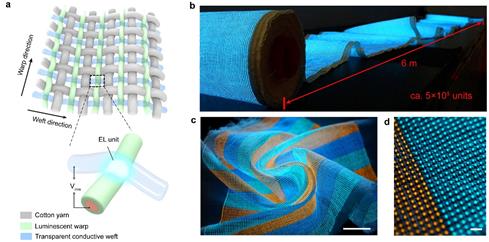 +565 975 658
+565 975 658
 info@premiumcoding.com
info@premiumcoding.com
 Monday - Friday, 8.00 - 20.00
Monday - Friday, 8.00 - 20.00
Displays are basic building blocks of modern electronics. Integrating displays into textiles offers exciting opportunities for smart electronic textiles—the ultimate goal of wearable technology, poised to change the way in which we interact with electronic devices. However, textiles with functional, large-area displays have not yet been achieved, because it is challenging to obtain small illuminating units that are both durable and easy to assemble over a wide area.
Display devices have evolved from rigid panels to flexible thin films. However, the configuration and fabrication of electronic textiles are different from conventional film devices, such as organic light-emitting diodes (OLEDs) that are currently used to construct flexible displays. On one hand, textiles are woven from fibers, forming rough and porous structures that can deform and fit the contours of the human body. OLEDs, on the other hand, are made by depositing multiple layers of semiconducting organic thin films between cathode and anode electrodes that are placed on planar substrates such as glass or plastic. Therefore, when attached onto the rough and deformable surfaces of textiles, these film devices often perform poorly or fail over time. Depositing luminescent layers on fibers that are suitable for weaving into flexible display textiles is also widely investigated. Although fiber light-emitting devices—such as optical fibers, polymer light-emitting electrochemical cell fibers and a.c. electroluminescence fibers—can be woven into lighting textiles, they generally show pre-designed patterns. The inability to dynamically control the pixels individually in real time according to input digital signals—as in standard display applications such as computers and mobile phones—is a considerable limitation.

Fig. 1 a, Schematic showing the weave diagram of the display textile. Each contacting luminescent warp and transparent conductive weft forms an electroluminescent (EL) unit (inset). An applied alternating voltage (Vrms) turns on the EL units. b, Photograph of a 6-m-long display textile consisting of approximately 5 × 105 EL units. c, Photograph of a functional multicolour display textile under complex deformations, including bending and twisting. d, Magnified photograph of the multicolour display textile shows that the EL units are uniformly spaced at a distance of ~800 μm. Scale bar, 2 mm.
Peng and coworkers report a 6-metre-long, 25-centimetre-wide display textile containing 5 × 105 electroluminescent units spaced approximately 800 micrometres apart. Weaving conductive weft and luminescent warp fibers forms micrometre-scale electroluminescent units at the weft–warp contact points. The brightness between electroluminescent units deviates by less than 8 per cent and remains stable even when the textile is bent, stretched or pressed. The display textile is flexible and breathable and withstands repeated machine-washing, making it suitable for practical applications. It is also showed that an integrated textile system consisting of display, keyboard and power supply can serve as a communication tool, demonstrating the system’s potential within the ‘internet of things’ in various areas, including healthcare. The approach unifies the fabrication and function of electronic devices with textiles, and Peng and his coworkers expect that woven-fiber materials will shape the next generation of electronics.
The report was published in Nature with Xiang Shi, Yong Zuo and Peng Zhai as co-first authors, Dr. Peining Chen and Professor Huisheng Peng as the corresponding authors. Shi, X.; Zuo, Y.; Zhai, P.; Shen, J.; Yang, Y.; Gao, Z.; Liao, M.; Wu, J.; Wang, J.; Xu, X.; Tong, Q.; Zhang, B.; Wang, B.; Sun, X.; Zhang, L.; Pei, Q.; Jin, D.; Chen, P.;# Peng, H.# Large-area display textiles integrated with functional systems. Nature 2021, 591 (7849), 240-245. Link: https://www.nature.com/articles/s41586-021-03295-8.
Get to know us better now!

Wechat:FDUMMers
Search!
Search across our website
Revenant @ 2018 by fudan | All Rights Reserved
Powered by Weicheng

